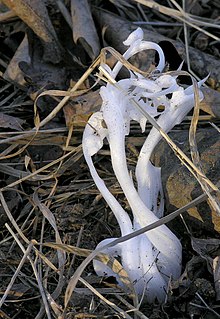Frost flower
This article needs additional citations for verification. (April 2010) |

A frost flower is formed when thin layers of ice are extruded from long-stemmed plants in autumn or early winter. The thin layers of ice are often formed into exquisite patterns that curl into "petals" that resemble flowers.
Types
Frost flower formations are also referred to as frost faces, ice castles, ice blossoms, or crystallofolia.
Types of frost flowers include needle ice, frost pillars or frost columns, extruded from pores in the soil, and ice ribbons, rabbit frost or rabbit ice, extruded from linear fissures in plant stems.[1] While the term ice flower is also used as synonym to ice ribbons, it may be used to describe the unrelated phenomenon of window frost as well.
Formation
The formation of frost flowers is dependent on a freezing weather condition occurring when the ground is not already frozen. The sap in the stem of the plants will expand (water expands when frozen), causing long, thin cracks to form along the length of the stem. Water is then drawn through these cracks via capillary action and freezes upon contact with the air. As more water is drawn through the cracks it pushes the thin ice layers further from the stem, causing a thin "petal" to form.
The petals of frost flowers are very delicate and will break when touched. They usually melt or sublimate when exposed to sunlight and are usually visible in the early morning or in shaded areas.
Examples of plants that often form frost flowers are white crownbeard (Verbesina virginica), commonly called frostweed, yellow ironweed (Verbesina alternifolia),[2] and Helianthemum canadense. They have also been observed growing from fallen branches of conifers and contain enough hydraulic power to strip the bark off.
-
Example of the hydraulic power of capilliary freezing
-
Frost flower closeup
-
Frost flower on a yellow ironweed stem in southern Missouri
See also
References
- ^ "Frost Flowers - different things - name conflict". my.ilstu.edu. Retrieved 2020-09-07.
- ^ Missouri Conservationist Magazine Oct. 2000 issue
- Carter, James R., Flowers and Ribbons of Ice, American Scientist, Sept. Oct. 2013, Vol. 101, #5, p. 360
- Coblentz, W. W., "The Exudation of Ice from Stems of Plants", Journal of the Franklin Institute, Nov 1914, 589-621
- Means, D. Bruce. "Blossoms of ice: these delicate "flowers" sprout only in winter, but you won't find them catalogued in any herbal". Natural History. February, 2004.
- Means, D. Bruce. "Mysterious Ice “Flowers” " American Gardener. Jan-Feb 2005, p. 34-8.
External links
- Ice Ribbons in East Tennessee
- Extruding Ice from Steel Fences and Pipes with Diurnal Freeze/Thaw
- Guide to Frost
- Frost flowers in Bambesch, Luxembourg, Jan.02.2010
- Crystallofolia (‘Frost Flowers’), with Stems of Frostweed (Verbesina virginica) & Marsh Fleabane (Pluchea odorata)
- Frost Flowers from the Mount Catria
- Geheimnisvoll und wunderschön - Wenn Eishaar aus Altholz wächst, Leonardo radio feature in WDR 5 (German)
- J.R. Carter, Illinois State University (ret.): Ice Flower website



